Cẩm nang Dòng chảy Môi trường
Dòng chảy môi trường đem lại lợi ích cho con người và thiên nhiên
Dòng chảy môi trường là chế độ nước được cung cấp trong một dòng sông, vùng đất ngập nước hoặc vùng ven bờ để duy trì các hệ sinh thái và những lợi ích của chúng ở những nơi dòng chảy bị điều tiết và có sự cạnh tranh trong sử dụng nước. Dòng chảy môi trường góp phần vô cùng quan trọng đối với sức khỏe của dòng sông, sự phát triển kinh tế và giảm đói nghèo. Chúng đảm bảo tính sẵn có liên tục của nhiều lợi ích mà dòng sông khỏe mạnh và các hệ thống nước dưới đất mang lại cho xã hội.
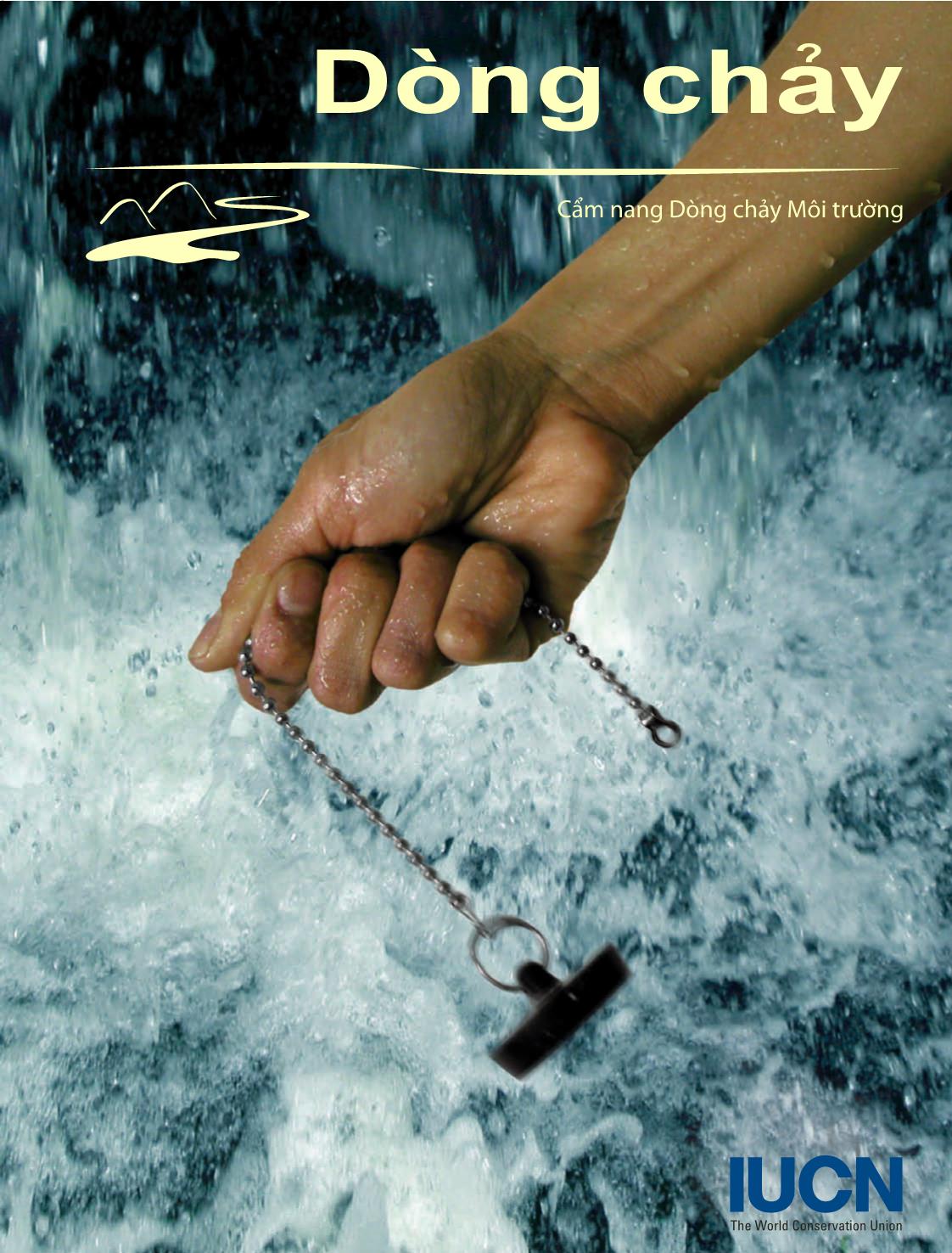
Trang 1

Trang 2
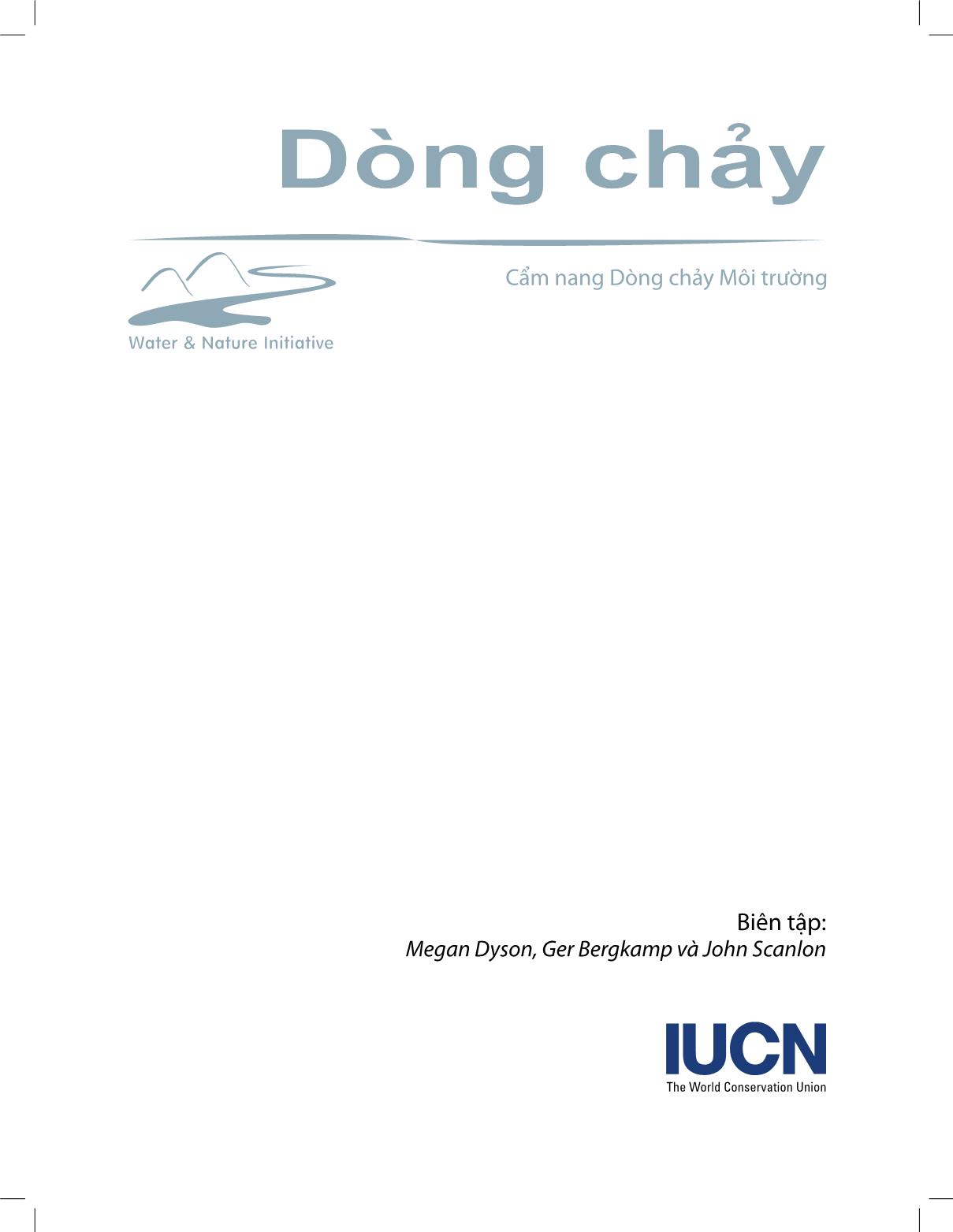
Trang 3
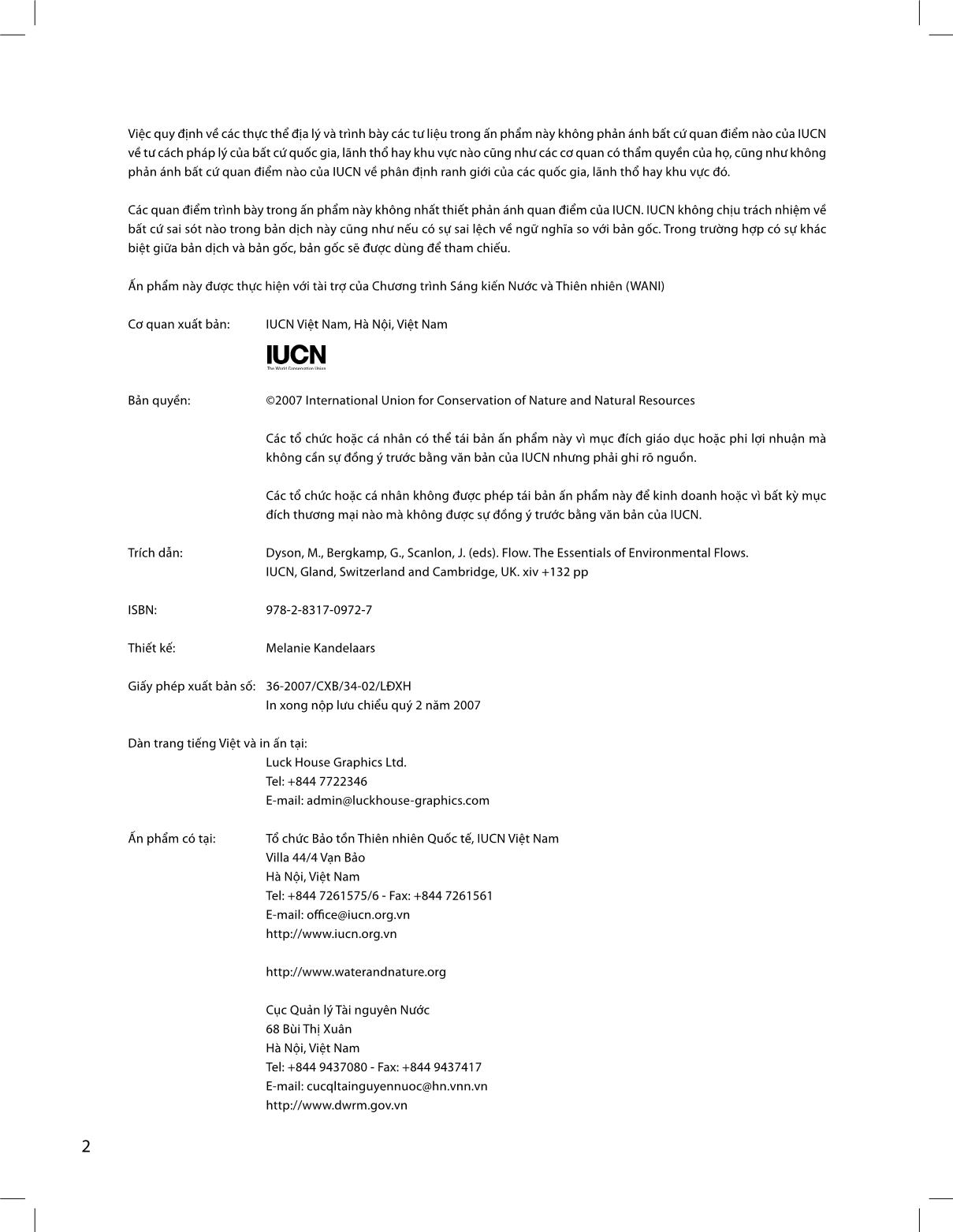
Trang 4

Trang 5

Trang 6
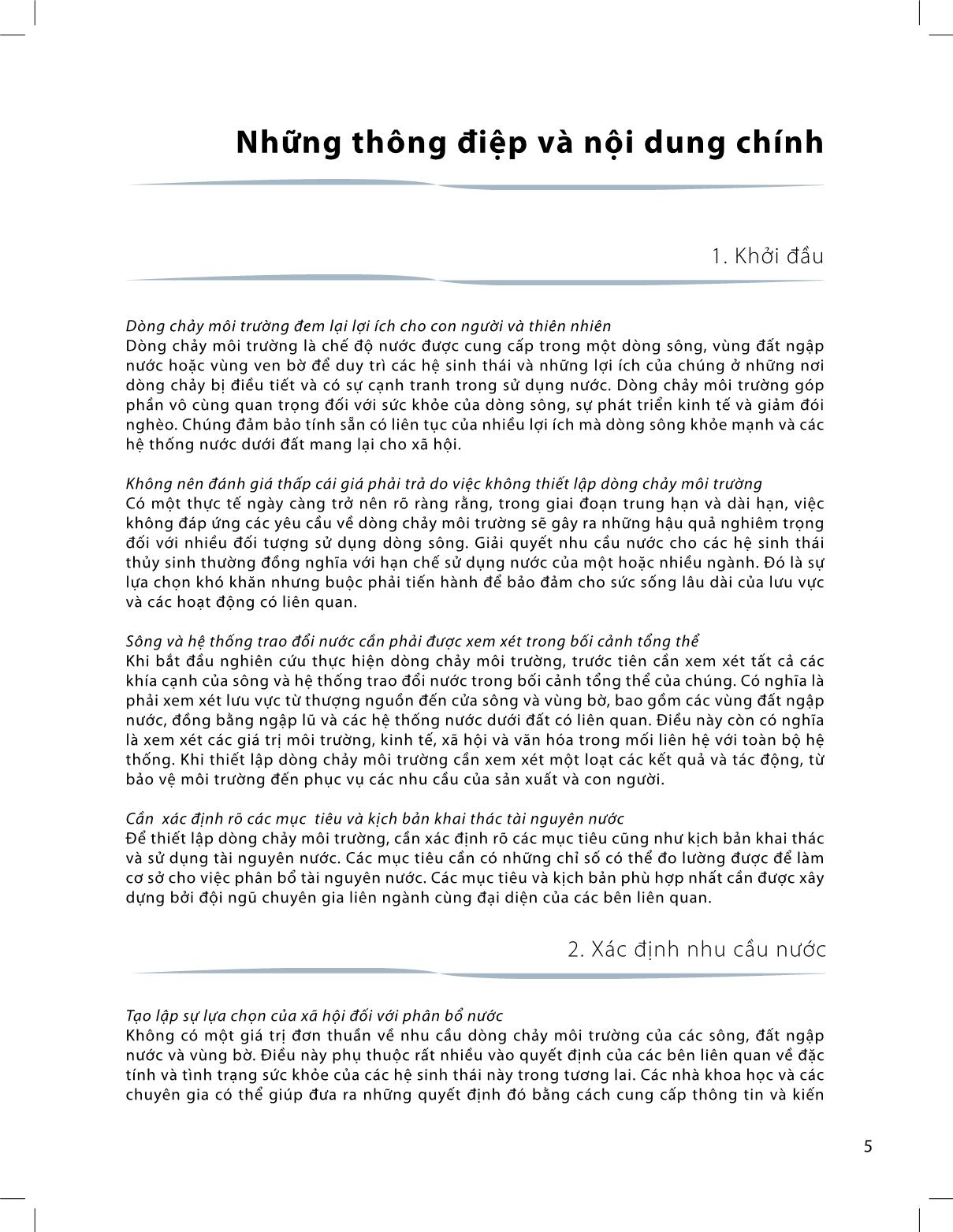
Trang 7
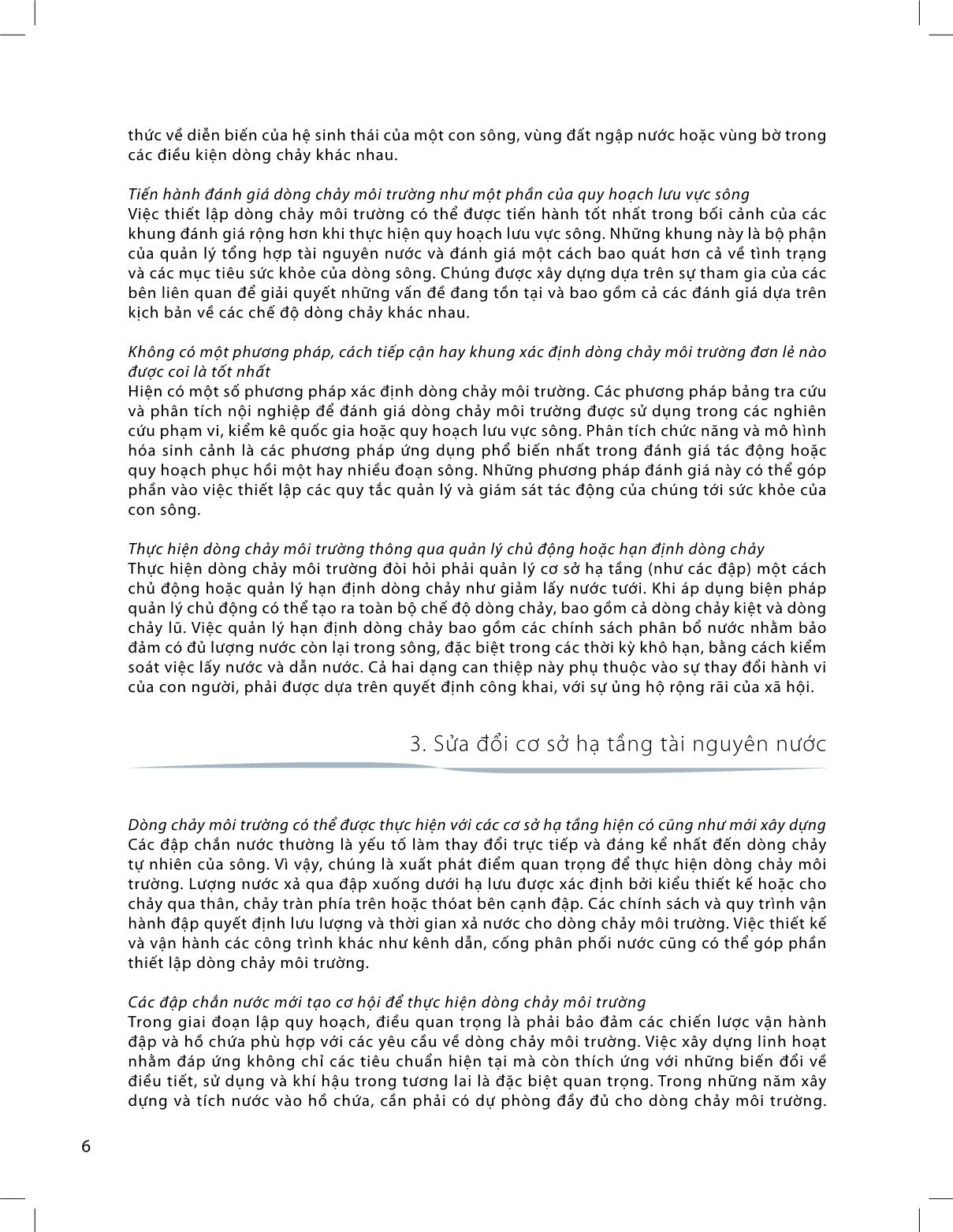
Trang 8
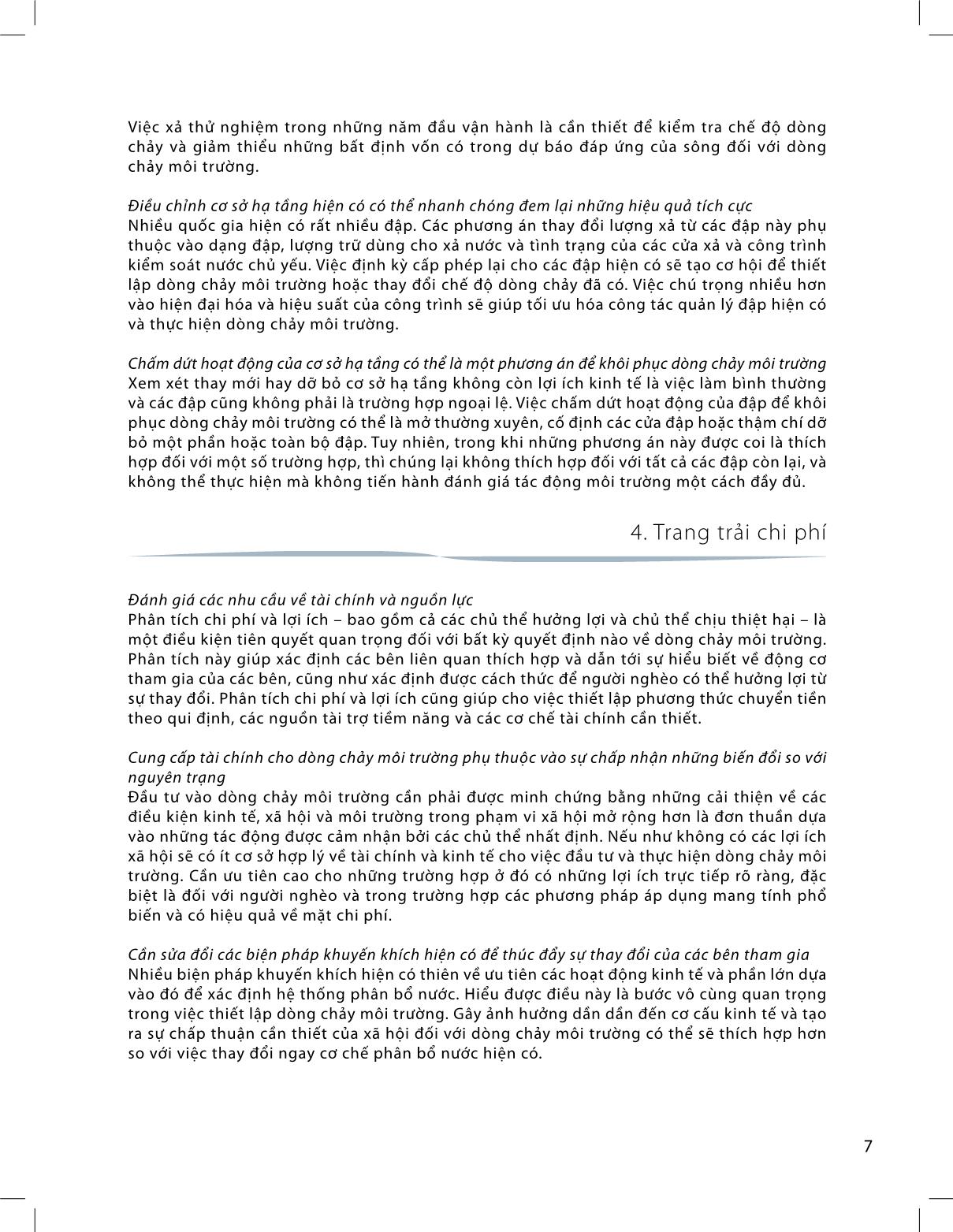
Trang 9
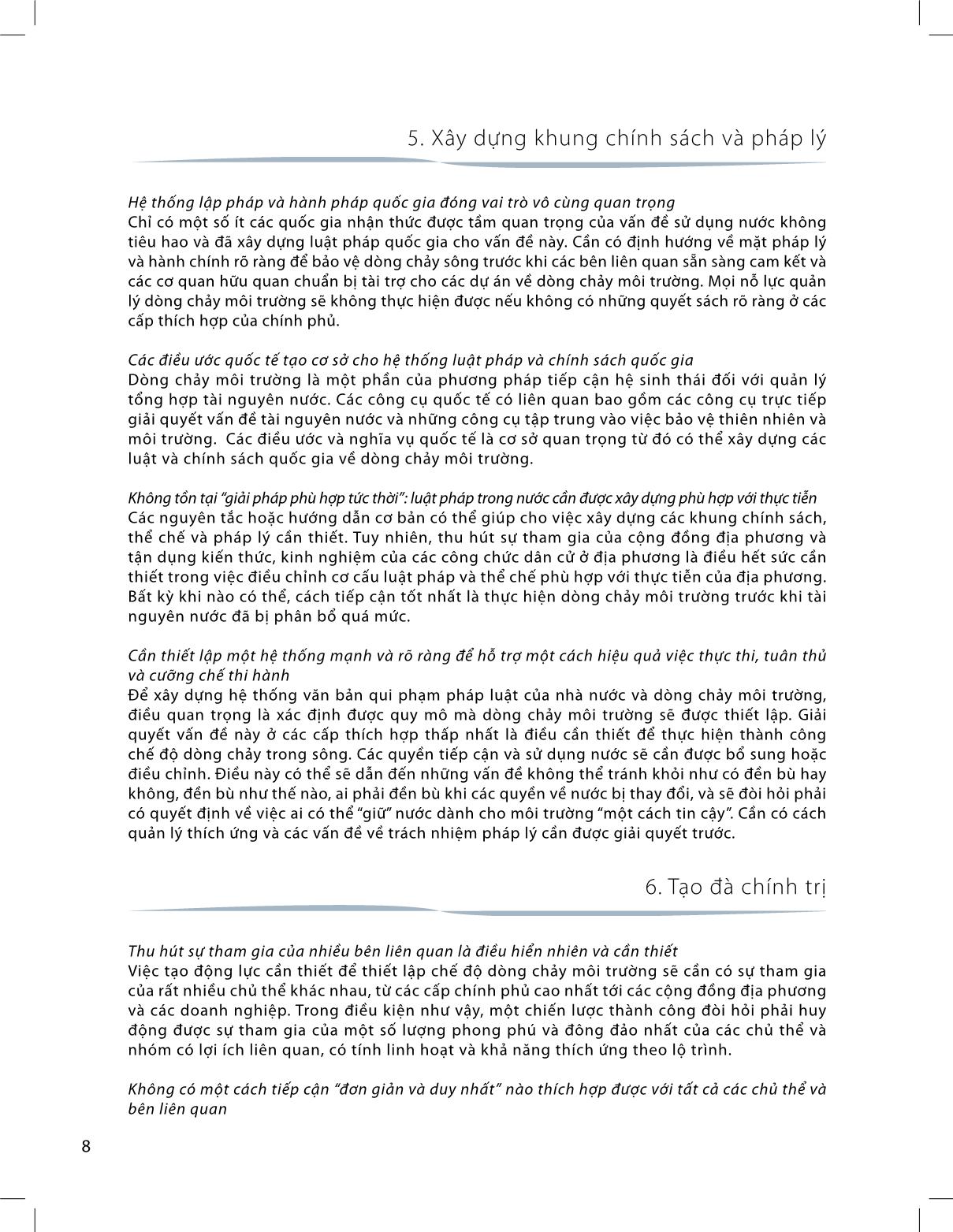
Trang 10
Tải về để xem bản đầy đủ
Bạn đang xem 10 trang mẫu của tài liệu "Cẩm nang Dòng chảy Môi trường", để tải tài liệu gốc về máy hãy click vào nút Download ở trên
Tóm tắt nội dung tài liệu: Cẩm nang Dòng chảy Môi trường
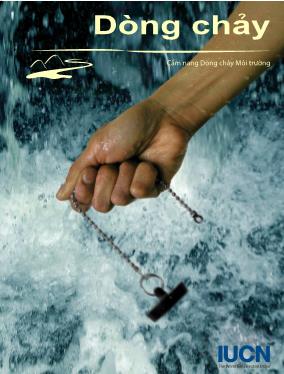
DÒNG CHẢY – Cẩm nang Dòng chảy Môi trường Tài liệu hướng dẫn này cung cấp những chỉ dẫn thực tiễn để thực hiện dòng chảy môi trường tại một số lưu vực sông trên thế giới, giải thích cách đánh giá các yêu cầu về dòng chảy, đề xuất những thay đổi, điều chỉnh cẩn thiết về khuôn khổ pháp lý và tài chính, huy động sự tham gia của các bên liên quan và tăng cường sự đồng thuận xã hội trong công tác quản lý tài nguyên nước. Cuốn sách kiến nghị một lộ trình thực hiện các giải pháp nhằm phòng, chống ô nhiễm, suy thoái, cạn kiệt nguồn nước, giải quyết sự xung đột do khan hiếm nguồn nước và suy thoái môi trường tiến tới hình thành một hệ thống quản lý tài nguyên nước có hiệu lực, thiết thực và hiệu quả, góp phần giảm đói nghèo, bảo đảm sự lành mạnh, bền vững của các dòng sông và chia sẻ, phân bổ nguồn nước một cách công bằng, hợp lý. Tổ chức Bảo tồn Thiên nhiên Quốc tế (IUCN) Tổ chức Bảo tồn Thiên nhiên Quốc tế (IUCN) quy tụ các quốc gia, các cơ quan chính phủ, và mạng lưới rộng khắp các tổ chức phi chính phủ trong một quan hệ đối tác duy nhất. Là một Hiệp hội các thành viên, IUCN tìm cách gây ảnh hưởng, khuyến khích và hỗ trợ các quốc gia và cộng đồng trên khắp thế giới bảo tồn sự toàn vẹn và tính đa dạng của thiên nhiên để bảo đảm việc sử dụng các nguồn tài nguyên thiên nhiên là công bằng và bền vững về sinh thái. Chương trình Sáng kiến Nước và Thiên nhiên (WANI) của IUCN Chương trình Sáng kiến Nước và Thiên nhiên (WANI) của IUCN là một chương trình hành động 5 năm nhằm chứng minh rằng cách tiếp cận quản lý hệ sinh thái và sự tham gia của các bên liên quan sẽ giúp giải quyết vấn đề hóc búa về tài nguyên nước hiện nay - trả lại sự sống cho các dòng sông và duy trì tài nguyên cơ sở đó cho nhiều đối tượng sử dụng. Cục Quản lý Tài nguyên Nước Cục Quản lý Tài nguyên Nước là tổ chức trực thuộc Bộ Tài nguyên và Môi trường, có chức năng giúp Bộ trưởng thực hiện nhiệm vụ quản lý nhà nước về tài nguyên nước bao gồm nước mưa, nước mặt, nước dưới đất, nước biển thuộc lãnh thổ và vùng biển nước Cộng hòa Xã hội Chủ nghĩa Việt Nam. Bộ máy giúp việc Cục trưởng gồm các phòng: Pháp chế, Quản lý Quy hoạch, Quản lý Điều tra Tài nguyên Nước, Quản lý Nước mặt, Quản lý Nước dưới đất, Bảo vệ Tài nguyên Nước, Đào tạo và Nâng cao nhận thức cộng đồng; Văn phòng Cục và các đơn vị sự nghiệp phục vụ công tác quản lý. C ẩm nang D òng chảy M ôi trư ờ ng D ò n g c h ä y C ẩ m n a n g D ò n g c h ả y M ô i t r ư ờ n g D ¼ N G C H Y C ẩm nang D òng chảy M ôi trư ờ ng D ¼ N G C H Y Biên tập: Megan Dyson, Ger Bergkamp và John Scanlon 2Việc quy định về các thực thể địa lý và trình bày các tư liệu trong ấn phẩm này không phản ánh bất cứ quan điểm nào của IUCN về tư cách pháp lý của bất cứ quốc gia, lãnh thổ hay khu vực nào cũng như các cơ quan có thẩm quyền của họ, cũng như không phản ánh bất cứ quan điểm nào của IUCN về phân định ranh giới của các quốc gia, lãnh thổ hay khu vực đó. Các quan điểm trình bày trong ấn phẩm này không nhất thiết phản ánh quan điểm của IUCN. IUCN không chịu trách nhiệm về bất cứ sai sót nào trong bản dịch này cũng như nếu có sự sai lệch về ngữ nghĩa so với bản gốc. Trong trường hợp có sự khác biệt giữa bản dịch và bản gốc, bản gốc sẽ được dùng để tham chiếu. Ấn phẩm này được thực hiện với tài trợ của Chương trình Sáng kiến Nước và Thiên nhiên (WANI) Cơ quan xuất bản: IUCN Việt Nam, Hà Nội, Việt Nam Bản quyền: ©2007 International Union for Conservation of Nature and Natural Resources Các tổ chức hoặc cá nhân có thể tái bản ấn phẩm này vì mục đích giáo dục hoặc phi lợi nhuận mà không cần sự đồng ý trước bằng văn bản của IUCN nhưng phải ghi rõ nguồn. Các tổ chức hoặc cá nhân không được phép tái bản ấn phẩm này để kinh doanh hoặc vì bất kỳ mục đích thương mại nào mà không được sự đồng ý trước bằng văn bản của IUCN. Trích dẫn: Dyson, M., Bergkamp, G., Scanlon, J. (eds). Flow. The Essentials of Environmental Flows. IUCN, Gland, Switzerland and Cambridge, UK. xiv +132 pp ISBN: 978-2-8317-0972-7 Thiết kế: Melanie Kandelaars Giấy phép xuất bản số: 36-2007/CXB/34-02/LĐXH In xong nộp lưu chiểu quý 2 năm 2007 Dàn trang tiếng Việt và in ấn tại: Luck House Graphics Ltd. Tel: +844 7722346 E-mail: admin@luckhouse-graphics.com Ấn phẩm có tại: Tổ chức Bảo tồn Thiên nhiên Quốc tế, IUCN Việt Nam Villa 44/4 Vạn Bảo Hà Nội, Việt Nam Tel: +844 7261575/6 - Fax: +844 7261561 E-mail: office@iucn.org.vn Cục Quản lý Tài nguyên Nước 68 Bùi Thị Xuân Hà Nội, Việt Nam Tel: +844 9437080 - Fax: +844 9437417 E-mail: cucqltainguyennuoc@hn.vnn.vn 3M ụ c l ụ c Những thông điệp và nội dung chính .............................................................................5 Lời nói đầu ...................................................................................................................10 Lời tựa ......................................................................... ... ls with multivariate habitat use models in Regulated Rivers, 14, 1-11 45 Guensch, G.R. Hardy, T.B. Addley, R.C. 2001. Examining feeding strategies and position choice of drift-feeding sal- monids using an individual-based, mechanistic foraging model Can J Fish Aquat Sci 58 (3): 446-457 46 Hardy, T.B. 1998. The future of habitat modeling and in-stream flow assessment techniques in Regulated Rivers 14 (5): 405-420 47 See, for example, Hardy, T.B. and Addley, R.C. 2001. Evaluation of Interim In-stream Flow Needs in the Klamath River, Phase II Final Report Institute for Natural Systems Engineering, Utah State University. 48 For example, the Expert Panel Assessment Method discussed earlier 49 Crance, J. H. 1987. Guidelines for using the Delphi Technique to develop habitat suitability index curves. US Fish and Wildlife Service Biological Report 82(10.134). Fort Collins, USA 50 King, J., Brown, C. and Sabet, H (in press) A scenario-based holistic approach to environmental flow assessments for rivers Rivers Research and Applications 51 Poff, N.L., Allan, J.D., Bain, M.B., Karr, J.R., Prestegaard, K.L., Richter, B.D., Sparks, R.E., Stromberg, J.C. 1997. The natural flow regime in Bioscience 47, 769-784 52 National Research Council, 1992. Restoration of aquatic ecosystems - science technology and public policy. National academic press, Washington DC, USA 53 United Nations, Conference on Sustainable Development, 1992 54 The Statement and Report from the International Conference on Water and the Environment (ICWE) in Dublin, Ireland express a holistic, comprehensive, multi-disciplinary approach to water resource problems worldwide, 1992 55 Chapter 5 contains an overview of Agenda 21 and a number of other international initiatives. 56 Graphic adapted from G.W. Annandale. 2000 Reservoir Conservation and Sediment Management, Engineering & Hydrosystems Inc.. 57 World Commission on Dams. 2000 Dams and Development, Earthscan, London. 58 59 Hirji, R.F. Ziegler, T.H.R. 1999. Ensuring Environmental Quality In Water Resource Projects, HRW, December Issue; see also the Lesotho Highlands website 60 World Commission on Dams. 2000 Dams and Development, Earthscan, London. 61 and 62 References for the examples are: Norris Dam: Outstanding Stewardship of American Rivers, 10 Hydro Projects Cited for Environmental Accomplishments, National Hydropower Association, 2001; Priest Rapids and Wanapum Dams: citation as above; Arrow Rock Dam: see US Bureau of Reclamation at and gov/pn/programs/arrowrockvalve/feis/complete.pdf; Stave Falls Replacement Project: Stave River Water Use Plan – Report of the Consultative Committee October 1999. See also 63 IRN, Getting Old: Dam Ageing and Decommissioning, at 64 World Commission on Dams, Case Study of the Pak Mun Dam, 2000 at http:www/dams.org; and more recent articles on the Thailand Cabinet decision in 2002 to keep the gates open four months a year - 65 66 Gauvin, C.F. 1998. Who Should Pay For Dam Removal?, World Rivers Review, Volume 13, No. 1 / February; and the Natural Resource Council of Maine (USA) at 67 WWF Poland. 2000. An options assessment for the Wloclawek dam: threats and solutions and 68 European Union. 2000 Directive of the European Parliament and of the Council 2000/60/EC establishing a frame- work for community action in the field of water policy. European Parliament and Council, Luxembourg. 69 Aylward et al, Financial, Economic and Distributional Analysis: World Commission on Dams, Cape Town 2001 1421 1 6 70 Howe, C.W Policy Issues and Institutional Impediments in the Management of Groundwater: Lessons from Case Studies in Environment and Development Economics (2002) 7 (at 769-795) 71 www.deschuteswe.org 72 National Hydropower Association, Outstanding Stewardship of America's Rivers. Washington, DC 2001 73 www.nfwf.org/watertransactionsprogram/ 74 Pagiola, S Paying for Water Services in Central America: Learning from Costa Rica in Pagiola, S. Bishop, J. Landell- Mills, N. 2002..Selling Forest Environmental Services: Market-based Mechanisms for Conservation, Earthscan, London; and Rojas, M., and Aylward, B (in press) What are we Learning from Experiences with Markets for Environmental Services in Costa Rica? A Review and Critique of the Literature. Report to IIED, International Institute for Environment and Development, London 75 Stevens, J.B., Adams, R.M., Barkley, D., Kiest, L.W., Landry, C.J., Newton, L.D., Obermiller, F.W., Perry, G.M., Seely, H., and Turner, B.P. 2000. Benefits, Costs, and Local Impacts of Market-based Streamflow Enhancements: The Deschutes River, Oregon, Rivers 7 (2):89-108. 76 Bjornlund, H., and McKay, J. 2000. Aspects of Water Markets for Developing Countries: Experiences from Australia, Chile, and the US in Environment and Development Economics 7 (769-795) 77 As recommended by Bjornlund, H., and McKay, J. 2000. 78 Otto, B. 2000. Paying for Dam Removal: A Guide to Selected Funding Sources American Rivers, Washington DC. 79 Adams et al, cited above 80 Ostrom, E., Schroeder, L., and Wynne, S Institutional Incentives and Sustainable Development. Infrastructure Policies in Perspective, p8. in Sabatier, P.A. (ed) 1993. Theoretical Lenses on Public Policy, Westview Press, Inc, Boulder 81 Knowler, D. 1999. Incentive Systems for Natural Resource Management: The Role of Indirect Incentives in Environmental Report Series No. 2, FAO, Rome 82 Colorado School of Law. 1997. 83 Jaeger, W.K., Doppelt, B. 2002. Benefits to Fish, Benefits to Farmers: Improving Streamflow and Water Allocation in the Northwest, Oregon State University, Corvallis 84 ECOLEX, a joint initiative of IUCN, UNEP and FAO, provides a comprehensive data base of all multilateral environ- mental agreements and soft law instruments, along with details of the parties to these instruments. See www.eco- lex.org 85 The IUCN Environmental Law Centre is in the process of finalizing an extensive data base on water related treaties, national legislation and case law, which will be available on the website. See www.iucn.org/themes/law See also the Atlas of International Freshwater Agreements (UNEP/DEWA/DPDL/RS.02-04), and International Water Law Project (www.internationalwaterlaw.org) 86 For example, does the Constitution include a right to a clean and healthy environment or a right to access to water? For more information on human rights and water visit the Water and Wetlands page of the IUCN Environmental Law Programme website: www.iucn.org/themes/law 87 In this context, the concept of international rivers is used to indicate a watercourse which geographically and eco- nomically affects the territory and interests of two or more states. In this paper, the concepts of transboundary and shared watercourse are used interchangeably 88 League of Nations, Treaty Series, Vol. VII, pp. 37 89 League of Nations, Treaty Series, Vol. XXXVI, pp. 77 90 May 21, 1997; 36 International Legal Materials (ILM) 700. This convention has not yet entered into force 91 The ILC is an organ of the United Nations in charge of the codification and progressive development of internatio- nal law 92 Adopted on 17 March 1992; entry into force on 6 October 1996. (1991) 30 ILM 800 93 4 April 1995; 34 ILM 864 94 Signed in Johannesburg on 28.08.95; available at 95 Signed on 2 February 1971, in force since 21 December 1975; 11 ILM 1972 96 Adopted on 16 November 1972, in force since 17 December 1975; 11 ILM, 1358 1431 1 7 97 Under the Ramsar Convention the List is determined by the State itself. Under the World Heritage Convention pro- posed sites are inscribed on the list following a decision of the World Heritage Committee 98 Concluded on 23 June 1979; in force since 1 November 1983. 19 ILM 15 99 Which has been signed by 16 and ratified by 12 countries 100 Article 5 and 6, UN Convention 101 Article 7, UN Convention 102 Article 8, UN Convention 103 Article 9, UN Convention 104 Since it does not have the characteristics distinguishing law from other social rules, e.g. authority and prescription, and are not within the sources of international law described in Article 38 of the International Court of Justice Statute 105 The Earth's Action Plan adopted at the United Nations Conference on Environment and Development, held at Rio de Janeiro, Brazil in 1992 106 See also The UN Millennium Development Goals, Part VI, Clause 23 107 For a review of the South African situation see: Stein, R. 2002. Water Sector Reforms in Southern Africa: Some Case Studies in Hydropolitics in the Developing World: A Southern African Perspective (Turton and Hinwood Eds, 2002) and American University. 2001. South Africa's Water and Dam Safety Legislation: A Commentary and Analysis on the Impact of the World Commission on Dams' Report, Dams and Development, International Law Review, Volume 16, Number 6. For a review of the Australian situation see: Arthington A and Pusey B. 2003. Flow Restoration and Protection in Australia, Rivers Research and Applications, and Scanlon J. 2002. From Taking to Capping to Returning: The Story of Restoring Environment Flows in the Murray Darling Basin in Australia, SIWI Annual Conference 108 24 January 1991. RO 1992 1860 109 U.S. Wild and Scenic Rivers Act: (P.L. 90-542, as amended), (16 U.S.C. 1271-1287) 110 1997, as amended 111 National Water Act. Act 36 of 1998 112 See paragraph 25(c) 113 See Chapter 4.4.6. For a recent case study see Dyson, M. Scanlon, J. 2002. Trading in Water Entitlements in the Murray-Darling Basin in Australia – Realizing the Potential for Environmental Benefits, p14. IUCN ELP Newsletter Issue 1, available at: www.iucn.org/themes/law 114 See National Competition Council, Compendium of National Policy Agreements – Second Edition, June 1998 115 See National Competition Council, Compendium of National Policy Agreements at page 99 116 Some countries may also already have in place a domestic regime that makes provision for environmental flows. If so, then this regime must be understood 117 The IUCN Environmental Law Programme can assist in providing a range of comparative models. Visit: www.iucn.org/themes/law or contact the IUCN Environmental Law Centre at: waterlaw@elc.iucn.org 118 Responsibility may reside with another level of government or another ministry/department 119 National Wildlife Federation and others v. United States Army Corps of Engineers, 132 F.Supp.2d 876 (D. Or. 2001). 120 See the Berlin Recommendations from the International round table on transboundary water management in 1998 and the Report of the World Commission on Dams, 2000 121 See Agenda 21 para 18.22. Most recently, the WSSD upheld the importance of the role of women and the Plan of Implementation recognizes that the outcomes of the Summit should benefit all, particularly women, youth, child- ren and vulnerable groups 122 The WSSD Political Declaration addressed this deficiency, emphasizing the importance of involving all groups in society 123 For information on where water law is being taught contact the IUCN Environmental Law Centre, Bonn at water- law@elc.iucn.org. The inauguration of the IUCN Commission on Environmental Law endorsed Water Law Centre of Excellence, Mandela Institute, Witwatersrand University, South Africa, will be held at the IUCN World Parks Congress, Durban, September 2003 124 King, J.M. Tharme, R.E. de Villiers, M.S. (eds.) 2003. Environmental flow assessments for rivers: manual for the Building Block Methodology. Water Research Commission Technology Transfer Report No. TT131/00. Pretoria, South Africa 125 Acreman, M.C. King, J.M. 2003. Building capacity to implement an environmental flow programme in Tanzania. Report of a mission to Tanzania 3-13 December 2002 World Bank Environmental Flows Window, World Bank, Washington,USA 144 Ảnh trang 20: © Akram Shahid / REUTERS Ảnh trang 25: © Jackie King Ảnh trang 35: © Jackie King Ảnh trang 35: © Cục Cá và động vật hoang dã, Hoa Kỳ Ảnh trang 55: © Tim Cullen / Ngân hàng Thế giới Ảnh trang 61: © Reinout van den Bergh / Hollandse Hoogte Ảnh trang 80: © Laurent Giraudou / Anzenberger Ảnh trang 86: © Amit Dave / REUTERS Ảnh trang 101: © Sukree Sukplang / REUTERS Ảnh trang 110: © DWAF / South Africa Ảnh trang 119: © Rafiqur Rahman / REUTERS Ảnh trang 137: © Jackie King Nguồn ảnh DÒNG CHẢY – Cẩm nang Dòng chảy Môi trường Tài liệu hướng dẫn này cung cấp những chỉ dẫn thực tiễn để thực hiện dòng chảy môi trường tại một số lưu vực sông trên thế giới, giải thích cách đánh giá các yêu cầu về dòng chảy, đề xuất những thay đổi, điều chỉnh cẩn thiết về khuôn khổ pháp lý và tài chính, huy động sự tham gia của các bên liên quan và tăng cường sự đồng thuận xã hội trong công tác quản lý tài nguyên nước. Cuốn sách kiến nghị một lộ trình thực hiện các giải pháp nhằm phòng, chống ô nhiễm, suy thoái, cạn kiệt nguồn nước, giải quyết sự xung đột do khan hiếm nguồn nước và suy thoái môi trường tiến tới hình thành một hệ thống quản lý tài nguyên nước có hiệu lực, thiết thực và hiệu quả, góp phần giảm đói nghèo, bảo đảm sự lành mạnh, bền vững của các dòng sông và chia sẻ, phân bổ nguồn nước một cách công bằng, hợp lý. Tổ chức Bảo tồn Thiên nhiên Quốc tế (IUCN) Tổ chức Bảo tồn Thiên nhiên Quốc tế (IUCN) quy tụ các quốc gia, các cơ quan chính phủ, và mạng lưới rộng khắp các tổ chức phi chính phủ trong một quan hệ đối tác duy nhất. Là một Hiệp hội các thành viên, IUCN tìm cách gây ảnh hưởng, khuyến khích và hỗ trợ các quốc gia và cộng đồng trên khắp thế giới bảo tồn sự toàn vẹn và tính đa dạng của thiên nhiên để bảo đảm việc sử dụng các nguồn tài nguyên thiên nhiên là công bằng và bền vững về sinh thái. Chương trình Sáng kiến Nước và Thiên nhiên (WANI) của IUCN Chương trình Sáng kiến Nước và Thiên nhiên (WANI) của IUCN là một chương trình hành động 5 năm nhằm chứng minh rằng cách tiếp cận quản lý hệ sinh thái và sự tham gia của các bên liên quan sẽ giúp giải quyết vấn đề hóc búa về tài nguyên nước hiện nay - trả lại sự sống cho các dòng sông và duy trì tài nguyên cơ sở đó cho nhiều đối tượng sử dụng. Cục Quản lý Tài nguyên Nước Cục Quản lý Tài nguyên Nước là tổ chức trực thuộc Bộ Tài nguyên và Môi trường, có chức năng giúp Bộ trưởng thực hiện nhiệm vụ quản lý nhà nước về tài nguyên nước bao gồm nước mưa, nước mặt, nước dưới đất, nước biển thuộc lãnh thổ và vùng biển nước Cộng hòa Xã hội Chủ nghĩa Việt Nam. Bộ máy giúp việc Cục trưởng gồm các phòng: Pháp chế, Quản lý Quy hoạch, Quản lý Điều tra Tài nguyên Nước, Quản lý Nước mặt, Quản lý Nước dưới đất, Bảo vệ Tài nguyên Nước, Đào tạo và Nâng cao nhận thức cộng đồng; Văn phòng Cục và các đơn vị sự nghiệp phục vụ công tác quản lý. C ẩm nang D òng chảy M ôi trư ờ ng D ò n g c h ä y C ẩ m n a n g D ò n g c h ả y M ô i t r ư ờ n g D ¼ N G C H Y C ẩm nang D òng chảy M ôi trư ờ ng D ¼ N G C H Y
File đính kèm:
 cam_nang_dong_chay_moi_truong.pdf
cam_nang_dong_chay_moi_truong.pdf

